, which roughly means "the laughing spot", is the name of a famous theatre in Osaka, where once a week a group of comedians dressed in traditional clothes hold a show based on jokes and comic stories.

FLOWER TURNING ULTRAMAN
this special edition is by Bandai (Japan)
Hana-mekuri Urutoraman is a recent Hanafuda cartoon edition (2004) dedicated to one of the earliest and most successful Japanese TV series, having been first broadcasted in 1966, and having lasted up to the late 1990s. Unlike other series that inspired fancy Hanafuda sets, this one is not an anime, but an action movie, with real actors.
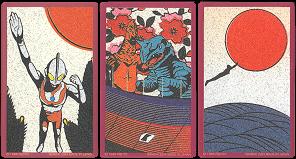
three light cards
|
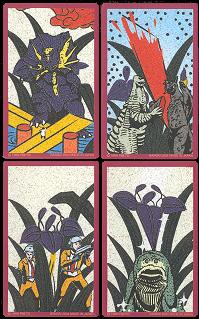
full suit of Iris |
The theme of the series is based on science-fiction; its many characters (each of which is generically called an "ultraman") are creatures from another world, who fight against the evil forces using their special powers, but also with martial arts, then turning into human beings when not in action. Their opponents take the shape of weird monsters, some of which are featured in various subjects.
|
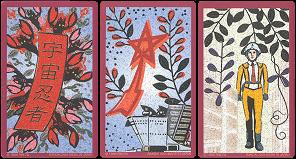
two tan (ribbon) cards and a kasu (trash) |

the 'rain' card |
The characters of the series variously interact with the traditional details of the Hanafuda pattern, but in this edition some of the ribbons are actually replaced by other details which resemble them, such as the trail of a star, a missile, etc. (bottom left); also the text they feature is not the traditional one, but consistent with the series (bottom right). |

EXTRAORDINARY VEGETABLE CARDS
this special edition is by Bandai (Japan)
The edition called Môretsu Yasai-fuda (roughly, "extraordinary vegetable cards") was issued in 1990. It is based on the series Môretsu Atarô ("extraordinary Ataro"), first broadcasted in 1969, created by Fujio Akatsuka, the same cartoonist who drew the Tensai Bakabon series described in part 1.
This set differs from most other editions for a number of reasons. In first place the cards are large, similar to the ones used for playing Iroha Karuta, i.e. almost double the size of a standard Hanafuda deck. Characters from the cartoon appear in each subject, but in this case the same personage is featured in all four cards of each suit, or family, in different attitudes.
two light cards from Matsu (pine) and Yanagi (willow) suits
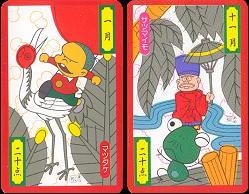 |
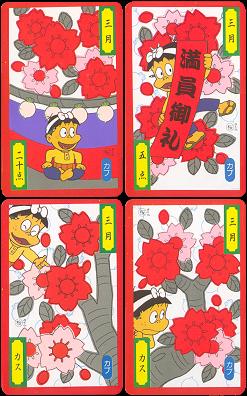
full suit of Sakura (Cherry) |
|
|
Each card has several small vertical writings, as shown on the left: the name of the month that matches the family or suit can be read in a yellow/green cartouche, and a similar one mentions the number of points the subject is worth (non-scoring cards read kasu, "trash"). Instead an oval cartouche in different colours features the name of a vegetable, such as "pumpkin", "turnip", "pepper", etc. (a different one for each suit, whence the name "vegetable cards" of this edition). Lastly, inscribed in a tiny circle is the real name of the suit (i.e. "pine", "plum", "cherry", etc.).
Also in this edition the text of the ribbons is non-standard. |
two tan (ribbon) cards from
Ume (plum) and Kiku (crysanthemum),
and a tane card from Susuki (eulalia);
the ribbons read "big bargain sale"
and "door", respectively |
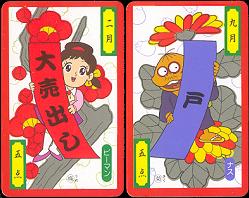 |
 |

HWATU CARD GAME
this special edition is by Candy (South Korea)
This edition, featuring teddy-bears and other cartoon characters, is a fancy variant of the
Hwatu pattern used in South Korea. Unlike the Japanese ones described so far, the cards are printed on ordinary (thin) cardstock, and also their size is larger than usual, almost as Western ones.
The composition of the deck is traditional, with 48 cards divided into twelve suits. Two extra cards are also included, in which the crane (from the Pine suit) and the man with the umbrella (from the Willow suit) stand in a white circle.
Besides the additional cartoon personages, each card has other unusual features: a line of text (in Korean), the word "ENERGY" followed by a number, a row of small stars immediately below, ranging from two to eleven, whose colour changes from subject to subject, while on the card's bottom border is a row of notches representing leds, some of which are coloured (i.e. lit); this can be seen more in detail in the enlargement below. Which is their purpose is difficult to tell, although these special features clearly suggest that the cards were drawn for a modern game rather than for traditional Hwatu. In fact, some "trash" cards have higher values or energy points than the scoring subjects (ribbons, cards, etc.) |
 |
In this edition the usual Chinese character is missing from the five "light" cards, replaced by a short text inside the disk, variously coloured.

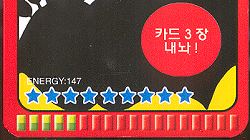
other pages in this gallery
OTHER GALLERIES






















or back to

HISTORICAL
NOTES
|

MULTI-LANGUAGE
GLOSSARY |

THE FOOL &
THE JOKER |

INDEX
TABLE |

REGIONAL
GAMES |

PLAYING CARD
LINKS |






















